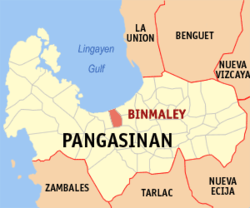Binmaley
| Binmaley | ||
|---|---|---|
| Municipality | ||
 |
||
|
||
 Map of Pangasinan showing the location of Binmaley |
||
| Location within the Philippines | ||
| Coordinates: 16°02′N 120°16′E / 16.033°N 120.267°ECoordinates: 16°02′N 120°16′E / 16.033°N 120.267°E | ||
| Country |
|
|
| Region | Ilocos (Region I) | |
| Province | Pangasinan | |
| District | 2nd district of Pangasinan | |
| Founded | February 1, 1590 | |
| Barangays | 33 | |
| Government | ||
| • Mayor | Simplicio Rosario | |
| • Vice Mayor | Edgar Mamenta | |
| • Electorate | 55,280 voters (2016 election) | |
| Area | ||
| • Total | 118.50 km2 (45.75 sq mi) | |
| Population (2015 census) | ||
| • Total | 83,052 | |
| • Density | 700/km2 (1,800/sq mi) | |
| Time zone | PST (UTC+8) | |
| ZIP code | 2417 | |
| 015513000 | ||
| Dialing code | +63 (0)75 | |
| Income class | 1st municipal income class | |
| Revenue | ₱ 20,949,580.90 (2016) | |
| Poverty incidence | 7.45 (2012) | |
Binmaley (Pangasinan: Baley na Binmaley; Ilocano: Ili ti Binmaley) is a 1st class municipality in the province of Pangasinan, Philippines. According to the 2015 census, it has a population of 83,052 people.
Binmaley is located along the western coastland of Pangasinan facing the Lingayen Gulf, in between Lingayen and Dagupan City. On January 8–9, 1945, the amphibious forces of U.S. General Douglas MacArthur used the town's beach, designated as "yellow beach", alongside the beaches of Lingayen, Dagupan, and San Fabian, in their landing operations to liberate Luzon from Japanese occupation during World War II.
The town is famous for its bangus (milkfish) aqua-culture, due to the existence of its numerous fishponds (pokok in the Pangasinan language). However, because of constant siltation over the past several years from mine tailings upstream from Agno River (due to mine operations in neighboring Benguet Province), and the overuse of artificial fish feeds, the bangus industry has suffered from fishkill, fewer viable fishponds and lower harvests. As a result, many formerly productive fishponds have been converted into large commercial and residential lots. This phenomenon is beginning to seriously threaten the unique Binmaley fishpond industry. Current Government action is inadequate due to strong pressures from other competing commercial interests, not to mention fishfeed producers.
Binmaley's town center has a Neo classical church dating back to the 17th century. It also became famous throughout the Philippines for the outstanding academic achievements of students (and its distinctive corps of military cadets) from its Binmaley Catholic High School, especially when it was headed by a German priest, Fr. Leo Behneke, in the 1960s and 1970s. Its name roughly means "the place which became a town" or "went to town" in the Pangasinan language.
...
Wikipedia


